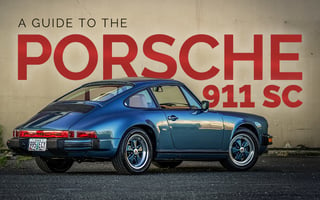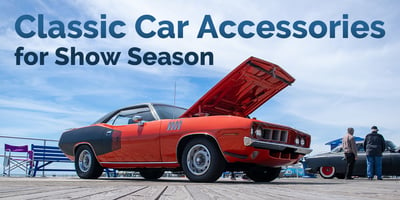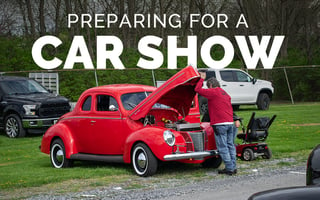Was the 1978-1983 Porsche 911SC the best car to ever wear the 911 badge? It’s a bold question to...
Shelby-Modified Chryslers Of The Eighties

Any time someone mentions Carroll Shelby, aka “The old chicken farmer”, the conversation naturally turns to the fast Fords that bore, and continue to bear, his name. And why not? From the early GT-350 through the Cobras and GT40s, all the way to the mighty Mustang GT500 of today, Shelby has been synonymous with weapon-grade performance from the Blue Oval. In fact, there are probably serious Carroll Shelby fans who know little or nothing about his “lost decade” of the eighties, where the most common “Shelby” you saw on the streets was a little four-cylinder Dodge hatchback with just 107 horsepower. Many more Shelby enthusiasts deliberately omit or gloss over his work with Chrysler, but doing so would be a mistake. Working with the Mopar gang not only kept Shelby in the performance-car game, but it also resulted in a lot of really neat vehicles, several of which we’ll discuss below.
1983 Dodge Shelby Charger: Where It Began

In the smog-strangled doldrums of 1982, Chrysler’s “Charger 2.2” was darned near as quick as the traditional RWD ponycars from Ford and General Motors, despite being nothing more than a Dodge Aries-K engine in a Dodge “024” subcompact hatchback. But the Mopar team could see the writing on the wall. A new generation of five-liter fuel-injected V-8s in the Mustang and Camaro would quickly render their sporting entries a distant also-ran. Having thrown all their weight into just two FWD platforms, the “L-car” that sat beneath the Omni/024 and the “K-car” that had to support everything else, Chrysler had no way to fight back…
...or did they? Lee Iacocca still had Carroll Shelby’s number in his Rolodex, and when he made the call, the pitch must have run something along the lines of: We’re the underdogs. Come work your magic and make a couple bucks. Shelby, meanwhile, was reportedly less than pleased by the implication that he was associated with the Fox-bodied turbo “Mustang Cobra” of 1979. Especially since he didn’t make a dime on it.
With little time and even less budget, Shelby focused on the easy wins with the Charger 2.2, releasing the Shelby Charger in 1983. The engine was bumped to 107 horsepower from the 84 horses of the standard car, which was a big deal. Suspension improvements made it handle. What grabbed the public’s imagination, however, was an extreme body kit and two-tone paint scheme. It looked more like a race car than anything else you could buy. Dealers and customers loved it. Just like that, Shelby was back in the fast-car biz.
1984 Omni GLH: The Rabbit Killer

Any mechanical package that would work in an L-body Charger would, of course, work in the more conservative-looking, but lighter, Omni four-door. Shelby’s chosen name for this hatchback which would do direct battle with the Rabbit GTI: Omni GLH, for Goes Like Hell. It had more power than the VW, turned better acceleration times, and even looked more menacing, courtesy of a “Darth Vader” blackout treatment.
1985 Shelby Charger Turbo: Now We’re Cooking

Chrysler’s answer to the return of V-8 power at its domestic competitors: turbocharge its 2.2-liter four-cylinder. By 1985 you could get a turbo 2.2 in nearly anything the company made, except for the L-body subcompacts. This omission was fixed with the Shelby Charger Turbo, which tucked much of the Daytona Turbo Z powertrain beneath the L-body hood. It was fast, with 146 horsepower to push much less weight than the ponycars had. And it looked the part. By this point, the public perception of the Shelby Charger was so good that Chrysler decided not to give it the new quad-lamp front end of the other 1984 and 1985 Chargers. Far from a quick graphics job, the Shelby Charger Turbo was the real deal. Buyers who wanted four doors could choose the Turbo I engine as an option in the Omni GLH-T.
1986 GLH-S and 1987 Charger GLH-S: The Purist’s Choice

For 1986, Shelby himself bought 500 GLH-T Omnis and had them further modified in his California facility. They were then titled as “Shelby Omni” rather than “Dodge Omni”. The engines were strengthened to 175 horsepower, using the external components of the upcoming Chrysler “Turbo II” engine but not the reinforced internals that would accompany it into production. Quarter-mile times were competitive with Corvettes and Mustangs of the time, and the Shelby employees affixed a “135” to the end of the speedometer, just to drive home the point.
Shelby would do the same thing in 1987 with 1,000 units of the two-door Charger, which was called “Charger GLH-S” for “Goes Like Hell Somemore.” All 1500 of these Chryslers are eligible for the Shelby Registry.
1987 Shelby Lancer and 1988-89 Lancer Shelby: Super Sedans

Chrysler’s Euro-influenced five-door sedan, the Dodge Lancer, went under the Shelby knife in California for 1987. The powertrain was the Turbo II 2.2-liter available in normal Lancers; the differences were in suspension, interior options, and exterior appearance. 800 were made, split evenly between automatic and manual transmission models.
Handsome and capable, the Shelby Lancer cost nearly as much as a base 3-Series BMW, which ensured it would remain a limited-production item at best. Dodge took production in-house for close to 500 additional “Lancer Shelby” sedans for 1988 and 1989. These are similar to the 1987 model but lack a few Shelby-installed suspension items. Fast and sleek, the Lancers tested Chrysler’s ability to compete with a new generation of European performance sedans.
1987 CSX: It All Comes Together

The Dodge Shadow (and its sibling Plymouth Sundance) were intended to replace the original K-car Aries/Reliant twins while addressing six years’ worth of changes in customer expectations. Naturally, Shelby got involved. The package of engine upgrades was the same as the Shelby Charger GLH-S, and the output was the same 175hp. 750 cars were modified in California with everything from special suspension to a unique steering wheel. For 1988, one thousand “CSX-T” models were built to be rented by Thrifty to eager and/or lucky customers. They didn’t get the engine upgrades. Another 750 1988 CSXes were made for private buyers. These were handsome and accomplished cars that could fly down a back road or around a racetrack.
1987-1991 Daytona Shelby Z: Front-drive ponycar

Time was cruel to the K-car-based Dodge Daytona performance coupe, and by 1987 it was handily outdone by its competitors. To keep a little bit of showroom momentum, the “Turbo Z” trim was replaced by “Shelby Z”. These cars were entirely built by Dodge, featuring the Turbo II engine and facelifts to the nose (in 1987) and interior (in 1990). The Shelby Z was discontinued after 1991, at which point high-performance Daytonas became known as “IROC” Daytonas. A few lucky buyers were able to get the “Turbo IV” variable-nozzle turbocharger engine in 1990, which made for a very driveable and real-world usable performance car.
1989 CSX-VNT: Plastic wheels and uncompromising performance

The last year of the CSX was a special Shelby indeed. It was the first production car to use a variable-nozzle turbocharger and the first production car to be sold with full-sized plastic wheels. Torque was up, though horsepower stayed the same, and the transmission was a higher-capacity Getrag. A new bodykit updated the already-aging Shadow for duty in the next decade, and Recaro seats were an option. 500 were built. The demise of Shelby’s Chrysler partnership put an end to plans for a 224-horsepower 1990 model, which would have had the engine that eventually powered the IROC Daytona.
1989 Shelby Dakota: Truckin’ into the future

Chrysler’s “right-sized” Dakota pickup was just the thing for a market that was increasingly interested in trucks for personal use. Shelby worked some real magic on 1,500 “Shelby Dakota” variants, including the fitment of a 318-cubic-inch V-8 and limited-slip differential. This made it Shelby’s first pickup truck and arguably the most-modified of any California-produced Chrysler/Shelby collaboration. It also predicted the future: the vast majority of Shelby-modified vehicles after 1990 would be rear-wheel-drive and V-8 powered. They just wouldn’t be Dodges.
Joining the Shelby family
While the market likes and respects the Shelby-modified Chryslers, values aren’t anywhere near what you’d pay for a Sixties Ford Shelby or a modern Shelby Mustang. This makes them great choices for the connoisseur on a budget. An early Shelby Charger or final CSX-VNT might be the most collectible in the long run, but just for having a good time, you can’t go wrong with any of them. Which was Lee Iacocca’s original idea, and still the best reason to become a Shelby owner.




